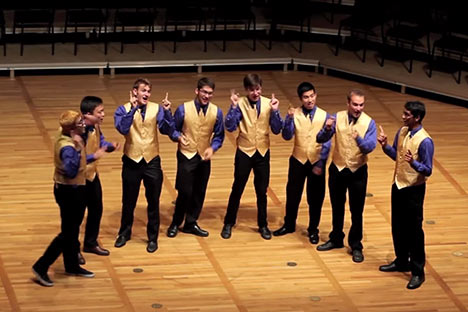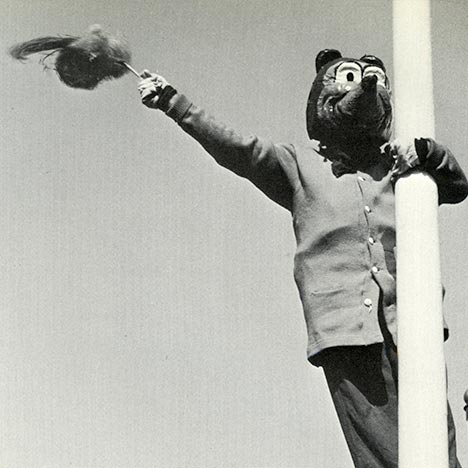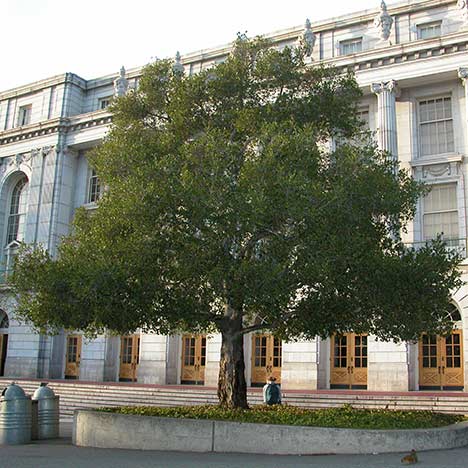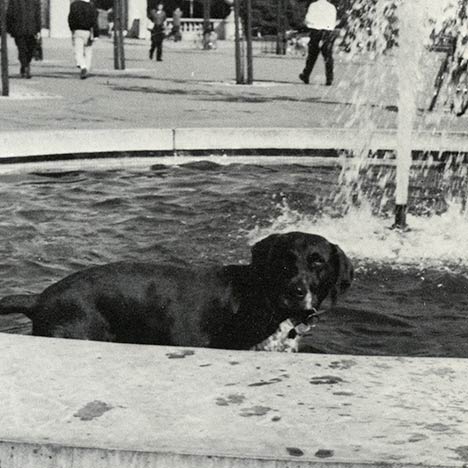Berkeley’s long and proud history has given rise to many traditions, rallies and rituals. Learn about the experiences that become a part of every Golden Bear’s time at Cal.
Blue and Gold
The campus colors of blue and gold were chosen in 1873 – blue for the California sky and ocean and for the Yale graduates who helped establish the university, gold for the “Golden State.” The women of the classes suggested using both colors.
Founders Rock
Trustees of the College of California stood on the north side of the campus near the corner of Hearst Avenue and Gayley Road on April 16, 1860, and dedicated the property as the future campus. A memorial tablet was placed on the stone in 1896.
The Big “C”
The Big “C” in the hills above campus was built in 1905 by the 1907 and 1908 classes. Sophomores were responsible for keeping the C clean and painted gold. On the night before a Stanford game or coast championship, the C was guarded through the night.
Card stunts
At the Big Game of 1914, colored cards supplied to Cal fans were held up in the rooting section according to direction to make a pattern. Over time card stunts became more elaborate, including the “Cal script,” in which a huge “Cal” appeared to be written.
Golden Bears
In 1895 a 12-man track team became the first Cal team to compete outside the state. They carried banners with the state’s emblem, a grizzly bear, in gold. The athletes won several meets, and the Golden Bear became the mythical guardian of the university.
Oski
Beloved mascot Oski was named for a cheer that began, “Oski wow wow! Whiskey wee wee!” Originally, real bear cubs served as mascots, but their growth posed obvious problems. Oski as we know him debuted at a 1941 freshman rally.
RRR week
In 1961 the students requested that the week before final exams become “Dead Week,” which we now refer to as Reading, Review and Recitation week. Quizzes, projects and activities are not scheduled to allow time to study and prepare for exams.
Wheeler Oak
The tree in front of the Wheeler Hall steps was a favorite meeting place for students between 1917 and 1934, when the oak had to be removed because of its age. The tree was so missed that another oak, and a bronze plaque, was planted in its place.
Ludwig’s Fountain
Soon after the Student Union complex opened in 1960, the nearby fountain became the favorite spot of a German short-haired pointer named Ludwig. Ludwig spent every day in the fountain, and in 1961 it was named in his honor.
Victory Cannon
The Victory Cannon was donated by the class of 1964 in time for the 1963 football season. The gun appeared at all home games and was fired at the Big Game whenever the football team scored a touchdown or safety, kicked a field goal or won a game.
Sophomore Lawn
Sophomore Lawn is the grass between California Hall and the Valley Life Sciences Building. Sophomore men would gather on the lawn to haze freshmen, who retaliated by burning their class numerals in the lawn at night. These days it’s a nice napping place.
4.0 ball
The stone ball in front of the Campanile is more than a century old, but this tradition is much newer. Just a few years ago, students began referring to the sphere as the “4.0 ball.” Rubbing it before taking an exam is considered good luck.
Spirit songs
From sporting events to graduation, and every kind of event in-between, you’ll hear one of Cal’s spirit songs being sung. Sing it loud you Bears!



















